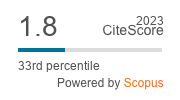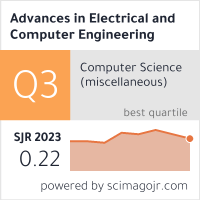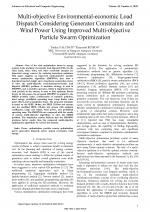| 4/2020 - 1 | View TOC | « Previous Article | Next Article » |
Multi-objective Environmental-economic Load Dispatch Considering Generator Constraints and Wind Power Using Improved Multi-objective Particle Swarm OptimizationYALCINOZ, T. |
| View the paper record and citations in |
| Click to see author's profile in |
| Download PDF |
Author keywords
optimization, particle swarm optimization, power generation dispatch, power system economics, wind energy
References keywords
power(29), dispatch(29), economic(26), optimization(21), swarm(20), algorithm(13), energy(11), objective(9), multiobjective(8), multi(8)
Blue keywords are present in both the references section and the paper title.
About this article
Date of Publication: 2020-11-30
Volume 20, Issue 4, Year 2020, On page(s): 3 - 10
ISSN: 1582-7445, e-ISSN: 1844-7600
Digital Object Identifier: 10.4316/AECE.2020.04001
Web of Science Accession Number: 000594393400001
SCOPUS ID: 85098149157
Abstract
One of the vital optimization issues in energy systems is the problem of economic load dispatch (ED). On the other hand, solar, wind, and other renewable energies are important energy sources for reducing hazardous emissions. This paper suggests an improved multi-objective particle swarm optimization algorithm (IMOPSO) that uses a functional inertial weight and a functional constriction factor to solve the multi-objective environmental-economic load dispatch (MEED) problem. A mutation strategy is used in IMOPSO, and a mutation operator, which is implemented for each particle in the swarm, is used to find optimum Pareto fronts. In this paper, the proposed IMOPSO is applied to the MEED problem under consideration of emission pollution, wind energy, prohibited operating zone, ramp limits, valve point effects, and transmission losses. The proposed technique is tested on the IEEE 30-bus, the IEEE 118-bus test system, and the modified IEEE 118-bus test system with emission coefficients, ramp rate limits, wind power, and prohibited operating zone. The IMOPSOs are compared with the results of various multi-objective algorithms to solve the MEED problem. The simulation results indicate that the IMOPSO produces better results than the compared multi-objective optimization algorithms for various test systems. |
| References | | | Cited By «-- Click to see who has cited this paper |
| [1] A. Farag, S. Al-Baiyat, T.C. Cheng, "Economic load dispatch multiobjective optimization procedures using linear programming techniques," IEEE Trans. Power Syst., vol.10, pp. 731-738, 1995. [CrossRef] [Web of Science Times Cited 299] [SCOPUS Times Cited 417] [2] A. J. Wood, B. F. Wollenberg, G. B. Sheble, Power Generation, Operation and Control, New Jersey, Wiley-IEEE, 3rd ed., 2013 [3] W. M. Lin, S. J. Chen, "Bid-based dynamic economic dispatch with an efficient interior point algorithm," Int J of Electrical Power & Energy Syst., vol. 24, pp. 51-57, 2002. [CrossRef] [Web of Science Times Cited 51] [SCOPUS Times Cited 68] [4] L. G. Papageorgiou, E. S. Fraga, "A mixed integer quadratic programming formulation for the economic dispatch of generators with prohibited operating zones," Electr. Power Syst. Res., vol. 77, pp. 1292-1296, 2007. [CrossRef] [Web of Science Times Cited 120] [SCOPUS Times Cited 147] [5] B. Mohammadi-Ivatloo, A. Rabiee and A. Soroudi, "Nonconvex dynamic economic power dispatch problems solution using hybrid immune-genetic algorithm," IEEE Systems Journal, vol. 7, no. 4, pp. 777-785, Dec. 2013, [CrossRef] [Web of Science Times Cited 65] [SCOPUS Times Cited 79] [6] Y. Qu, Y. S. Zhu, Y. C. Jiao, et al, "A survey on multi-objective evolutionary algorithms for the solution of the environmental/economic dispatch problems," Swarm and Evolutionary Comp., vol. 38, pp. 1-11, 2018. [CrossRef] [Web of Science Times Cited 156] [SCOPUS Times Cited 184] [7] N. Noman, H. Iba, "Differential evolution for economic load dispatch problems," Elect. Power Syst. Res., vol. 78, pp. 1322-1331, 2008. [CrossRef] [Web of Science Times Cited 338] [SCOPUS Times Cited 435] [8] C. Chelladurai, A. A. Victoire, "Crisscross optimization with comprehensive vertical crossover to solve combined economic emission dispatch," Advances in Electrical and Computer Engineering, vol.18, no.3, pp.131-140, 2018, [CrossRef] [Full Text] [9] A. Bhattacharya, P. K. Chattopadhyay, "Biogeography-based optimization for different economic load dispatch problems," IEEE Trans. Power Syst., vol. 25, pp. 1064-1077, 2010. [CrossRef] [Web of Science Times Cited 324] [SCOPUS Times Cited 445] [10] T. Yalcinoz, K. Rudion, "Economic load dispatch using an improved particle swarm optimization based on functional constriction factor and functional inertia weight," The 19th IEEE Int. Conf. on Environment and Electrical Engineering, Genoa, Italy, 11-14 June 2019. [CrossRef] [SCOPUS Times Cited 8] [11] G. Abbas, J. Gu, U. Farooq, et al, "Solution of an economic dispatch problem through particle swarm optimization: A detailed survey - Part I," IEEE Access, vol. 5, pp. 15105-15141, 2017. [CrossRef] [Web of Science Times Cited 78] [SCOPUS Times Cited 97] [12] V. K. Jadoun, N. Gupta, K. R. Niazi, A. Swarnkar, "Modulated particle swarm optimization for economic emission dispatch," Int J Electr Power Energy Syst., vol. 73, pp. 80-88, 2015. [CrossRef] [Web of Science Times Cited 73] [SCOPUS Times Cited 89] [13] K. K. Mandal, S. Mandal, B. Bhattacharya, N. Chakraborty, "Non-convex emission constrained economic dispatch using a new self-adaptive particle swarm optimization technique," Appl. Soft Comput., vol. 28, pp. 188-195, 2015. [CrossRef] [Web of Science Times Cited 47] [SCOPUS Times Cited 61] [14] A. Y. Abdelaziz, E. S. Ali, S. M. Abd Elazim, "Implementation of flower pollination algorithm for solving economic load dispatch and combined economic emission dispatch problems in power systems," Energy, vol. 101, 506-518, 2016. [CrossRef] [Web of Science Times Cited 135] [SCOPUS Times Cited 152] [15] D. C. Secui, "A method based on the ant colony optimization algorithm for dynamic economic dispatch with valve-point effects," Int Trans Electr Energ Syst., vol. 25, pp. 262-287, 2015. [CrossRef] [Web of Science Times Cited 15] [SCOPUS Times Cited 22] [16] S. Hemamalini, S. P. Simon, "Dynamic economic dispatch using artificial immune system for units with valve-point effect," Int J Electr Power Energy Syst., vol. 33, pp. 868-874, 2011. [CrossRef] [Web of Science Times Cited 117] [SCOPUS Times Cited 145] [17] I. A. Farhat, M. E. El-Hawary, "Dynamic adaptive bacterial foraging algorithm for optimum economic dispatch with valve-point effects and wind power," IET Gener Trans Distrib., vol. 4, pp. 989-999, 2010. [CrossRef] [Web of Science Times Cited 59] [SCOPUS Times Cited 84] [18] S. Ma, Y. Wang, Y. Lv, "Multiobjective environment/ economic power dispatch using evolutionary multiobjective optimization," IEEE Access, vol. 6, pp. 13066-13074, 2018. [CrossRef] [Web of Science Times Cited 13] [SCOPUS Times Cited 19] [19] D. W. Gong, Y. Zhang, C. L. Qi, "Environmental/economic power dispatch using a hybrid multi-objective optimization algorithm," Int J. Electr Power Energy Syst., vol. 32, pp. 607-614, 2010. [CrossRef] [Web of Science Times Cited 127] [SCOPUS Times Cited 168] [20] D. B. Das, C. Patvardhan, "New multi-objective stochastic search technique for economic load dispatch," IEE Proc Gener Trans Distrib., vol. 145, pp. 747-752, 1998. [CrossRef] [Web of Science Times Cited 138] [SCOPUS Times Cited 185] [21] M. A. Abido, "A niched Pareto genetic algorithm for multiobjective environmental/ economic dispatch," Int J Electr Power Energy Syst., vol. 25, pp. 97-105, 2003. [CrossRef] [Web of Science Times Cited 250] [SCOPUS Times Cited 310] [22] M. A. Abido, "Multiobjective evolutionary algorithms for electric power dispatch problem," IEEE Trans Evol Comput., vol. 10, pp. 315-329, 2006. [CrossRef] [Web of Science Times Cited 451] [SCOPUS Times Cited 654] [23] S. Agrawal, B. K. Panigrahi, M. K. Tiwari, "Multiobjective particle swarm algorithm with fuzzy clustering for electrical power dispatch," IEEE Trans Evol Comput., vol. 12, pp. 529-541, 2008. [CrossRef] [Web of Science Times Cited 244] [SCOPUS Times Cited 315] [24] M. A. Abido, "A novel multiobjective evolutionary algorithm for environmental/economic power dispatch," Electr Power Syst Res., vol. 65, pp. 71-81, 2003. [CrossRef] [Web of Science Times Cited 238] [SCOPUS Times Cited 326] [25] R. H. Bhesdadiya, I. N. Trivedi, P. Jangir, et al, "An NSGA-III algorithm for solving multi-objective economic/environmental dispatch problem," Cogent Eng., vol. 3, pp. 1269383, 2016. [CrossRef] [Web of Science Times Cited 45] [SCOPUS Times Cited 56] [26] S. Sivasubramani, K. S. Swarup, "Environmental/economic dispatch using multi-objective harmony search algorithm," Electr Power Syst Res., vol. 81, pp. 1778-1785, 2011. [CrossRef] [Web of Science Times Cited 119] [SCOPUS Times Cited 140] [27] J. Kennedy, R.C. Eberhart, "Particle swarm optimization," Proceedings of ICNN'95 - International Conference on Neural Networks Perth, WA, Australia, pp. 1942-1948, 1995. [CrossRef] [Web of Science Times Cited 32088] [28] M. R. Bonyadi, Z. Michalewicz, "Particle swarm optimization for single objective continuous space problems: a review," Evolutionary Computation, vol. 25, pp. 1-54, 2017. [CrossRef] [Web of Science Times Cited 445] [SCOPUS Times Cited 508] [29] M. Clerc, J. Kennedy, "The particle swarm explosion, stability, and convergence in a multidimensional complex space," IEEE Trans Evolutionary Computation," vol. 6, pp.58-73, 2002. [CrossRef] [Web of Science Times Cited 6153] [SCOPUS Times Cited 7855] [30] A. Ratnaweera, S. K. Halgamuge, H. C. Watson, "Self-organizing hierarchical particle swarm optimizer with time-varying acceleration coefficients," IEEE Trans Evolutionary Computation, vol. 8, pp. 240-255, 2004. [CrossRef] [Web of Science Times Cited 2189] [SCOPUS Times Cited 2836] [31] C. Sun, J. Zeng, J. Pan, S. Xue, Y. Jin, "A new fitness estimation strategy for particle swarm optimization," Information Sciences," vol. 221, pp. 355-370, 2013. [CrossRef] [Web of Science Times Cited 96] [SCOPUS Times Cited 113] [32] A. Nickabadi, M. M. Ebadzadeh, R. Safabakhsh, "A novel particle swarm optimization algorithm with adaptive inertia weight," Applied Soft Comp., vol. 11, pp. 3658-3670, 2011. [CrossRef] [Web of Science Times Cited 563] [SCOPUS Times Cited 707] [33] Y. Lu, M. Liang, Z. Ye, L. Cao, "Improved particle swarm optimization algorithm and its application in text feature selection," Applied Soft Comp., vol. 35, pp. 629-636, 2015. [CrossRef] [Web of Science Times Cited 98] [SCOPUS Times Cited 123] [34] M. Abido, "Optimal power flow using particle swarm optimization," Int J Electr Power Energy Syst., vol. 24, pp. 563-571, 2002. [CrossRef] [Web of Science Times Cited 787] [SCOPUS Times Cited 1031] [35] J. G. Vlachogiannis, K. Y. Lee, "A comparative study on particle swarm optimization for optimal steady-state performance of power systems," IEEE Trans. Power Syst., vol. 21, pp. 1718-1727, 2006. [CrossRef] [Web of Science Times Cited 180] [SCOPUS Times Cited 251] [36] G. Pranava, P.V. Prasad, "Constriction coefficient particle swarm optimization for economic load dispatch with valve point loading effects," Int Conf Power Energy Control, Sri Rangalatchum Dindigul, India, pp. 350-354, 2013. [CrossRef] [SCOPUS Times Cited 25] [37] C. C. A. Coello, G. T. Pulido, M. S. Lechuga, "Handling multiple objectives with particle swarm optimization," IEEE Trans Evol Comput., vol. 8, pp. 256-279, 2004. [CrossRef] [Web of Science Times Cited 2987] [SCOPUS Times Cited 3882] [38] C. C. A. Coello, "An introduction to multi-objective particle swarm optimizers," Gaspar-Cunha A, Takahashi R, Schaefer G, Costa L, (eds) Soft Computing in Industrial Applications, Advances in Intelligent and Soft Computing, Springer, Berlin, Heidelberg, pp. 96, 2011. [CrossRef] [SCOPUS Times Cited 28] [39] P. K. Tripathi, S. Bandyopadhyay, S. K. Pal, "Multi-objective particle swarm optimization with time variant inertia and acceleration coefficients," Information Sciences, vol. 177, pp. 5033-5049, 2007. [CrossRef] [Web of Science Times Cited 413] [SCOPUS Times Cited 514] [40] O. R. Castro, G. M. Fritsche, A. Pozo, "Evaluating selection methods on hyper-heuristic multi-objective particle swarm optimization," J Heuristics, vol. 24, pp. 581-616, 2018. [CrossRef] [Web of Science Times Cited 10] [SCOPUS Times Cited 11] [41] C. L. Chen, T. Y. Lee, R. M. Jan, "Optimal wind-thermal coordination dispatch in isolated power systems with large integration of wind capacity," Energy Conversion and Management, vol. 47, pp. 3456-3472, 2006. [CrossRef] [Web of Science Times Cited 91] [SCOPUS Times Cited 122] [42] S. S. Reddy, "Optimal scheduling of thermal-wind-solar power system with storage," Renewable Energy, vol. 101, pp. 1357-1368, 2017. [CrossRef] [Web of Science Times Cited 173] [SCOPUS Times Cited 211] [43] P. Partha, P. N. Biswas, B. Y. Suganthan, et al, "Multiobjective economic-environmental power dispatch with stochastic wind-solar-small hydro power," Energy, vol. 150, pp. 1039-1057, 2018. [CrossRef] [Web of Science Times Cited 167] [SCOPUS Times Cited 209] Web of Science® Citations for all references: 49,942 TCR SCOPUS® Citations for all references: 23,032 TCR Web of Science® Average Citations per reference: 1,135 ACR SCOPUS® Average Citations per reference: 523 ACR TCR = Total Citations for References / ACR = Average Citations per Reference We introduced in 2010 - for the first time in scientific publishing, the term "References Weight", as a quantitative indication of the quality ... Read more Citations for references updated on 2024-07-21 23:31 in 281 seconds. Note1: Web of Science® is a registered trademark of Clarivate Analytics. Note2: SCOPUS® is a registered trademark of Elsevier B.V. Disclaimer: All queries to the respective databases were made by using the DOI record of every reference (where available). Due to technical problems beyond our control, the information is not always accurate. Please use the CrossRef link to visit the respective publisher site. |
Faculty of Electrical Engineering and Computer Science
Stefan cel Mare University of Suceava, Romania
All rights reserved: Advances in Electrical and Computer Engineering is a registered trademark of the Stefan cel Mare University of Suceava. No part of this publication may be reproduced, stored in a retrieval system, photocopied, recorded or archived, without the written permission from the Editor. When authors submit their papers for publication, they agree that the copyright for their article be transferred to the Faculty of Electrical Engineering and Computer Science, Stefan cel Mare University of Suceava, Romania, if and only if the articles are accepted for publication. The copyright covers the exclusive rights to reproduce and distribute the article, including reprints and translations.
Permission for other use: The copyright owner's consent does not extend to copying for general distribution, for promotion, for creating new works, or for resale. Specific written permission must be obtained from the Editor for such copying. Direct linking to files hosted on this website is strictly prohibited.
Disclaimer: Whilst every effort is made by the publishers and editorial board to see that no inaccurate or misleading data, opinions or statements appear in this journal, they wish to make it clear that all information and opinions formulated in the articles, as well as linguistic accuracy, are the sole responsibility of the author.





